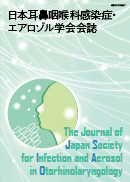6 巻, 2 号
選択された号の論文の8件中1~8を表示しています
- |<
- <
- 1
- >
- >|
総説
-
2018 年 6 巻 2 号 p. 55-60
発行日: 2018/05/20
公開日: 2020/08/04
PDF形式でダウンロード (1191K) -
2018 年 6 巻 2 号 p. 61-66
発行日: 2018/05/20
公開日: 2020/08/04
PDF形式でダウンロード (879K)
原著
-
2018 年 6 巻 2 号 p. 67-72
発行日: 2018/05/20
公開日: 2020/08/04
PDF形式でダウンロード (1331K)
症例
-
2018 年 6 巻 2 号 p. 73-78
発行日: 2018/05/20
公開日: 2020/08/04
PDF形式でダウンロード (3392K) -
2018 年 6 巻 2 号 p. 79-83
発行日: 2018/05/20
公開日: 2020/08/04
PDF形式でダウンロード (1344K) -
2018 年 6 巻 2 号 p. 84-87
発行日: 2018/05/20
公開日: 2020/08/04
PDF形式でダウンロード (1654K) -
2018 年 6 巻 2 号 p. 88-92
発行日: 2018/05/20
公開日: 2020/08/04
PDF形式でダウンロード (3446K)
解説
-
2018 年 6 巻 2 号 p. 93-96
発行日: 2018/05/20
公開日: 2020/08/04
PDF形式でダウンロード (1042K)
- |<
- <
- 1
- >
- >|
